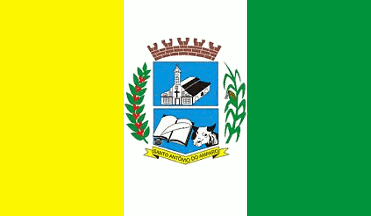 image by
Dirk Schönberger, 6 September 2010
image by
Dirk Schönberger, 6 September 2010Source: adapted from http://servidor7.molservidores.com

Last modified: 2017-05-31 by ian macdonald
Keywords: minas gerais | santo antônio do amparo |
Links: FOTW homepage |
search |
disclaimer and copyright |
write us |
mirrors
 image by
Dirk Schönberger, 6 September 2010
image by
Dirk Schönberger, 6 September 2010
Source:
adapted from
http://servidor7.molservidores.com
An off-centred red cross, fimbriated white, on a dark blue field, a white disk on the cross bearing the municipal arms.
Official website at
http://www.santoantoniodoamparo.mg.gov.br/. The flag was adapted from
http://servidor7.molservidores.com/~saa/index.php?view=article&catid=109%3Aintitucional&id=630%3Abrasao&format=html&option=com_content&Itemid=148.
Dirk Schönberger,
6 September 2010
The flag, prescribed by Law No. 653 of 28 February 1984 and designed by
Geraldo Martins Reis, is vertically divided yellow-white-green with the
municipal coat of arms in the middle. The Law prescribes a size of 1.30 m x 1.90
m and three equal vertical stripes of 0.57 cm x 0.24 m (sic), yellow, white and
green.
The coat of arms represented on the flag, whose photo is shown on
the municipal website is:
"Azure, per fess 1. a church argent masoned sable,
2a. a book argent a quill or, 2b. an oxen's head brown. The shield surmounted by
a mural crown argent masoned sable. The shield flanked dexter by a millet plant
proper and sinister by a coffee branch proper. Under the shield a scroll argent
a writing sable a year / the name of the municipality / a year."
The coat
of arms used on the municipal website and on Dirk's "hybrid" image seems to be a
modernized version of the previous one, as:
"Azure, per fess 1. a church
argent masoned and roofed sable, 2. a book, a quill and an oxen's head all
argent. The shield surmounted by a
mural crown brown masoned argent. The
shield flanked dexter by a coffee branch proper and sinister by a corn plant
proper. Under the shield a scroll or a writing sable the name of the
municipality."
The mural crown recalls the legal status of the town. The
church represents religion. The book and quill represent culture. The oxen
represents cattle-breeding and the plants represent agriculture.
Ivan
Sache, 11 September 2010